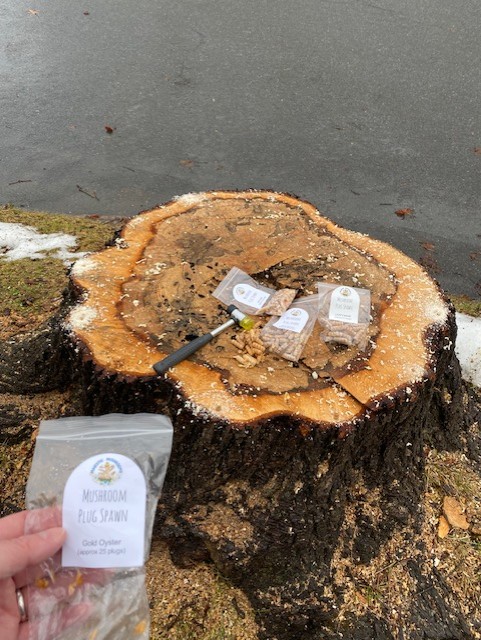
 1
1




 5
5








 2
2




Muddling towards a more permanent agriculture. Not after a guru or a religion, just a functional garden.
 4
4




Brenda
Bloom where you are planted.
http://restfultrailsfoodforestgarden.blogspot.com/
 2
2




Dale Hodgins wrote: When I bought my land it was covered in Douglas fir stumps. I found this quite distressing and considered hiring a machine to pull them. They are breaking down nicely on their own now and with a small amount of compost added to hollowed out tops they will become planters soon.
Nine years ago I stuck the tip of my chainsaw deep into a few of these stumps and peed in the holes regularly. I also covered a couple with dog shit. These stumps rotted faster than the others. I probably should have added lime. The fastest rotting of all was one that got the pee and poo treatment and was then covered with a compost pile consisting mostly of scotch broom which is a legume. This one is unrecognizable as a stump now.
The large root structures of my stumps absorb plenty of water during the winter so it's unlikely that I'll need to water these flowerpots very often.
Outside of grinding and excavating, does anyone have other techniques to expedite the decomposition of tree stumps?
 1
1




 1
1




L. Jones wrote:Best success IME is to have an entire pile of manure completely covering the stump. That way it's not got the opportunity to dry out as with a pile just on top, or being peed on - feel free to pee on the pile, of course. Add more manure if any stump sticks out. If you are in a hurry (relatively speaking) take a pick to the stump after a year or two and worry off any chunks that will come free, then rebuild with fresh manure. Otherwise just give it a few years (In drier climes that's probably a few years and some water, or cover the manure pile with a layer of plastic to hold water in, or something like that - not needed here.)
For lawn tree stumps, this then becomes a flowerbed. I supposed here it would be more popular to call it a hugelkulture, since everything is more exotic "auf Deutsch." Anyway, planting something should help move the process along, though things will plant themselves if you don't bother to plant it.
Certainly the last batch of manure I got was loaded with mushroom spore (and mushrooms, and no, it wasn't "mushroom compost" - just an outside pile of horse poo. Presumably some fraction of those go after the wood, and the nitrogen helps balance out the stump's carbon.
 2
2




 2
2








 1
1




"We're all just walking each other home." -Ram Dass
"Be a lamp, or a lifeboat, or a ladder."-Rumi
"It's all one song!" -Neil Young




 If someone is setup for doing a bit of Mycology. There are several species that have their niche growing area in the roots or root/butt interface
If someone is setup for doing a bit of Mycology. There are several species that have their niche growing area in the roots or root/butt interface  One of the most medicinal and edible of gourmets, Grifola frondosa (Hen of the Woods), grows in such a habitat.
One of the most medicinal and edible of gourmets, Grifola frondosa (Hen of the Woods), grows in such a habitat.



Brenda Groth wrote:if it is a fairly fresh stump, why not plug it with some mushroom plugs..(check with fungi perfecti)




 There is a species or two of Chicken of the Woods that should be well of For, as well... There are also some "root-rot" and "butt-rot" fungi that might work; but I would have to look it up
There is a species or two of Chicken of the Woods that should be well of For, as well... There are also some "root-rot" and "butt-rot" fungi that might work; but I would have to look it up 









 2
2












 3
3




Jay Green wrote:
Another method is soaking them in old cooking oil, build a fire cairn over them and let them burn
"It might have been fun to like, scoop up a little bit of that moose poop that we saw yesterday and... and uh, put that in.... just.... just so we know." - Paul W.
 2
2




if you wonder about my spelling🤔 i have dyslexia ore to say it in other words.
From my perspective every thing looks raigth. And if i try to find my misspellings, this makes it kind of complicated 





 1
1




Some places need to be wild




sow…reap…compost…repeat
 5
5




Thank you in advance to everyone for their replies, help, and suggestions! Forgive me if I miss any replies, I'm still learning how to keep up with threads I participate in!
 3
3




Thank you in advance to everyone for their replies, help, and suggestions! Forgive me if I miss any replies, I'm still learning how to keep up with threads I participate in!

 3
3





- Tim's Homestead Journal - Purchase a copy of Building a Better World in Your Backyard - Purchase 6 Decks of Permaculture Cards -
- Purchase 12x Decks of Permaculture Cards - Purchase a copy of the SKIP Book - Purchase 12x copies of Building a Better World in your Backyard

|
Would anybody like some fudge? I made it an hour ago. And it goes well with a tiny ad ...
The new gardening playing cards kickstarter is now live!
https://www.kickstarter.com/projects/paulwheaton/garden-cards
|







